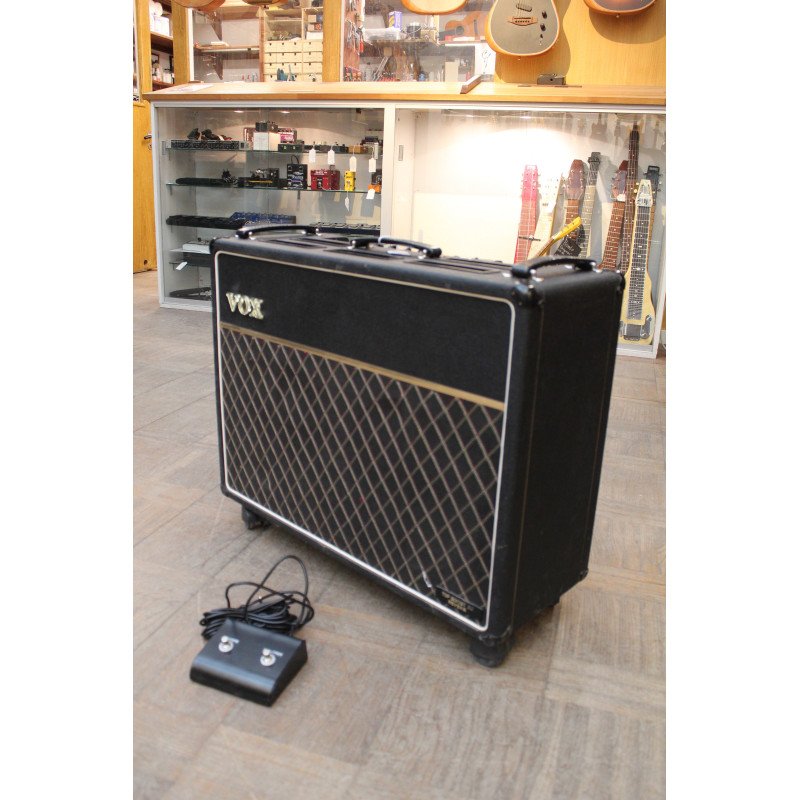
- SOLD!
1972 Vox AC-30 Top Boost Reverb
Birch-Stolec offered the first version of the AC-30 combo that included reverb as an option. The addition of reverb to the AC-30 became a necessity due to the increased UK popularity of the Fender Twin Reverb. The control panel mounted rotary voltage selector was eliminated to make room for the reverb control.
Very Good condition, 7/10, has just been serviced and works well, Made in the UK by Vox Sound Ltd, including a newer footswitch, the logo has been replaced to look like a 60´s AC30 (the original was a square 1970´s logo which can be supplied upon request), replaced knobs, replaced reverb tank which is not that great so the Reverb effect is really weak, , aftermarket wheels have been installed, the speakers are 2pc 12inch Alnico Silver Bulldogs which may or may not be original but this was the type that these amps came with back in the day, more info: After Tom Jennings was fired from JMI in 1967, the glory days of the "British Invasion" era ended for Vox. Vox would now suffer an uncertain future and a series of rapid ownership changes. The downward spiral for Vox started with the bankruptcy of the Royston Group in 1967. This led to the formation and subsequent failure of Vox Sound Equipment Limited in 1968 and 1969. The investment firm Corinthian Securities purchased Vox in 1969 and sold it to Birch-Stolec Ltd and the Schroder Bank in 1970.Birch-Stolec Ltd. Founded by John Birch and John Stole and financed by the Schroder Bank, Birch-Stolec Ltd was a manufacturing and distribution firm that marketed Eveready Batteries, John Birch sunglasses and electronic components in the UK. After Birch-Stolec Ltd. purchased Vox in 1970, they moved the manufacturing facilities from Erith, Kent to one of their existing facilities in Hastings, Essex. Birch-Stolec Era Vox Products The management at Birch-Stolec Ltd. continued to build the series of solid state Vox amplifiers (Supreme, Defiant, Foundation Bass and Super Foundation) whose modular, printed circuit construction was designed for cost efficiency and ease of manufacture. Birch-Stolec also desired to produce the iconic AC-30, whose hand wired tube design was still commercially viable but expensive and time consuming to manufacture. Birch-Stolec decided to reduce AC-30 production costs by replacing the original hand wired design with two printed circuit boards. Birch-Stolec did not understand the problems this redesign would create. Printed Circuit Board Construction Printed circuit board construction is best suited for transistorized circuits where both heat and current draw are minimized. Designing a tube amp on a printed circuit board presents a number of engineering challenges. Problems can occur when too much current is drawn through a circuit trace. A circuit trace can be vaporized by excessive current draw, in turn causing a failure. Something as common as a shorted tube can lead to this problem. Such failures could easily occur on the Birch-Stolec AC-30. Heat related failures also haunted the Birch-Stolec AC-30. All of the tube sockets for the Birch-Stolec AC-30 were mounted directly to the printed circuit board. This allowed the heat from the tubes to transfer directly to the PCB, often causing the circuit board to warp. The fragile nature of the printed circuit boards in the Birch-Stolec era AC-30 gave the amp a bad reputation for dependability. In later years, innovations in design, such as mounting the tube sockets to the chassis rather than to the PCB, allowed circuit boards to be successfully incorporated into the AC-30. Soon after Dallas Musical Industries purchased Vox from Birch-Stolec in 1973, Dallas replaced the printed circuit AC-30 with a hand wired model.



















